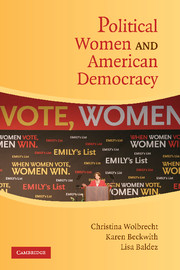Book contents
- Frontmatter
- Contents
- Preface
- List of Contributors
- Political Women and American Democracy
- 1 Introduction: What We Saw at the Revolution: Women in American Politics and Political Science
- 2 Gender as a Category of Analysis in American Political Development
- 3 Gender, Public Opinion, and Political Reasoning
- 4 Gender in the Aggregate, Gender in the Individual, Gender and Political Action
- 5 What Revolution? Incorporating Intersectionality in Women and Politics
- 6 Women's Movements and Women in Movements: Influencing American Democracy from the “Outside”?
- 7 Representation by Gender and Parties
- 8 Women as Candidates in American Politics: The Continuing Impact of Sex and Gender
- 9 Women as Officeholders: Linking Descriptive and Substantive Representation
- 10 Theorizing Women's Representation in the United States
- 11 Political Women in Comparative Democracies: A Primer for Americanists
- 12 Conclusion: Between Participation and Representation: Political Women and Democracy in the United States
- References
- Index
8 - Women as Candidates in American Politics: The Continuing Impact of Sex and Gender
Published online by Cambridge University Press: 05 September 2012
- Frontmatter
- Contents
- Preface
- List of Contributors
- Political Women and American Democracy
- 1 Introduction: What We Saw at the Revolution: Women in American Politics and Political Science
- 2 Gender as a Category of Analysis in American Political Development
- 3 Gender, Public Opinion, and Political Reasoning
- 4 Gender in the Aggregate, Gender in the Individual, Gender and Political Action
- 5 What Revolution? Incorporating Intersectionality in Women and Politics
- 6 Women's Movements and Women in Movements: Influencing American Democracy from the “Outside”?
- 7 Representation by Gender and Parties
- 8 Women as Candidates in American Politics: The Continuing Impact of Sex and Gender
- 9 Women as Officeholders: Linking Descriptive and Substantive Representation
- 10 Theorizing Women's Representation in the United States
- 11 Political Women in Comparative Democracies: A Primer for Americanists
- 12 Conclusion: Between Participation and Representation: Political Women and Democracy in the United States
- References
- Index
Summary
Taking the long view of women candidates in the United States, the contemporary time is one of unbelievable success and promise. Gone are the days of public rejection of the idea of a political life for women, of political parties only supporting women in hopeless situations, when campaign money was reserved for serious candidates (read: men) with a chance of winning. Instead we routinely see thousands of women running for, and winning, office at every level all over the country. Each election year brings more women candidates than the year before. In 2007, 86 women serve in Congress, 1,734 women hold seats in state legislatures, 77 women are statewide elected officials, and hundreds, if not thousands, of women serve in local elected office (Center for American Women and Politics [CAWP] 2007a). However, at the same time, we know that the people we still refer to as “women candidates” make up a much smaller percentage of the candidate population than they do of the general population, that these women are viewed by the public through the lens of stereotypes, and that sex and gender considerations, although not necessarily disabling, are ever-present on the campaign trail. For all of the success of women candidates, women in office only represent between 15 and 25 percent of the offices at any level of government. So today we are presented with the classic “half empty–half full” scenario.
- Type
- Chapter
- Information
- Political Women and American Democracy , pp. 110 - 127Publisher: Cambridge University PressPrint publication year: 2008
- 14
- Cited by



